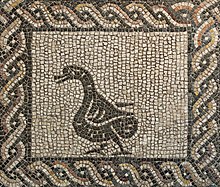Pavimentum


Pavimentum (plural: pavimenti , from the Latin pavitum “stamped”) describes any type of solid or solid floor coverings in ancient architecture .
Solidified floors made of tamped clay, lime concrete or mixtures with chippings, quarry stone or broken bricks have been proven in prehistoric times, for example in Troy I. Concrete floors , painted stucco floors on a concrete base, pebble floors and paving are known from Mycenaean times . This means that the main types of Pavimenti were essentially known from the early days:
- mechanically (by tamping), chemically (by adding burnt lime) or by adding it (gravel, chippings, etc.)
- poured floors (concrete, stucco, plaster)
- paved floors
- with cut slabs of stone (e.g. marble),
- with broken stones or cobblestones, or
- with ceramic plates (tiles)
- Multi-layer floors
In classical Greece, the multi-layer floor structure was further developed. Vitruvius describes a floor shape common for dining rooms (triclinium): a layer of mortar approx. 15 cm thick is poured over an approx. 45 cm thick layer of shards and rubble, whereby the mortar made of lime, sand, ash and coal dust results in a black coating that Finally, it is smoothed with stones, which, as Vitruvius notes, results in a black floor covering that is both attractive and inexpensive and easy to care for.
As a special form of the stone pavement floor there was the so-called lithostroton made of small, irregular colored marble stones, which is different from the actual mosaic floor .
We are well informed about the Roman techniques of soil construction both from the sources and through archaeological finds (especially from Pompeii and Herculaneum ). Floors made of Opus signinum were particularly widespread : mortar with mixed in gravel, terracotta or ceramic fragments was smoothed in such a way that a marble effect was created.
There were other more elaborate forms of floor design:
- Pavimentum Tessellatum : simpler, mostly two-tone mosaic floors, mainly with geometric ornaments (see also Opus tessellatum )
- Pavimentum Vermiculatum : Floors with multi-colored picture mosaics, mostly used parts of a larger mosaic floor
- Pavimentum Sectile : in principle, inlaid work from precisely cut stone slabs (see also Opus sectile )
literature
- Marion Elizabeth Blake: The pavements of the Roman buildings of the Republic and early Empire. American Academy, Rome 1930
- M. Donderer: The ancient Paviment types and their names. In: Yearbook of the German Archaeological Institute 102 (1987). Pp. 365-377
- Walter Hatto Gross : Pavimentum. In: The Little Pauly (KlP). Volume 4, Stuttgart 1972, Sp. 575 f.
- Christoph Höcker : Metzler Lexicon of Ancient Architecture. 2nd edition Metzler, Stuttgart 2008, ISBN 978-3-476-02294-3 . P. 193
